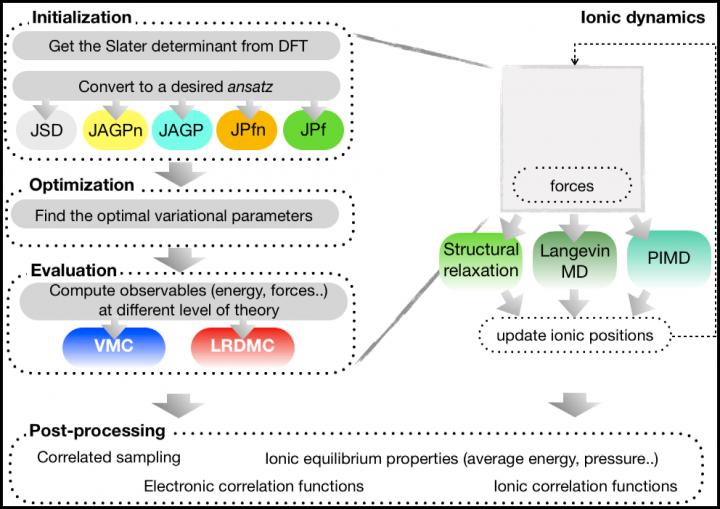
Credit: AIP Publishing
First-principles quantum Monte Carlo is a framework used to tackle the solution of the many-body Schrödinger equation by means of a stochastic approach. This framework is expected to be the next generation of electronic structure calculations because it can overcome some of the drawbacks in density functional theory and wavefunction-based calculations. In particular, the quantum Monte Carlo framework does not rely on exchange-correlation functionals, the algorithm is well suited for massively parallel supercomputers, and it is easily applicable to both isolated and periodic systems.
“TurboRVB” is a first-principles quantum Monte Carlo software package that was initially launched by Prof. Sandro Sorella (International School for Advanced Studies/Italy) and Dr. Michele Casula (Sorbonne University/France), and has been continuously developed by many contributors for over 20 years. Very recently, Assist. Prof. Kosuke Nakano at Japan Advanced Institute of Science and Technology (JAIST, President: Minoru Terano, located at Nomi, Ishikawa, Japan) and his collaborators have published a comprehensive review paper in The Journal of Chemical Physics [K. Nakano et al. J. Chem. Phys. 152, 204121, 2020, DOI: 10.1063/5.0005037].
TurboRVB is distinguishable from other first-principles quantum Monte Carlo codes in the following features. (a) The code employs resonating valence bond (RVB)-type wave functions, such as the Jastrow Geminal/Jastrow Pfaffian, which include the correlation effect beyond the Jastrow-Slater wave function that is commonly used in other QMC codes. (b) Implemented state-of-art optimization algorithms, such as the stochastic reconfiguration and the linear method, help realize a stable optimization of the amplitude and nodal surface of a many-body wave function at the variational quantum Monte Carlo level. (c) The so-called lattice-regularized diffusion Monte Carlo method is implemented in the code, which provides a numerically stable diffusion quantum Monte Carlo calculation. (d) The implementation of an adjoint algorithmic differentiation allows us to compute derivatives of many-body wave functions very efficiently and to perform structural optimizations and molecular dynamics simulations.
###
The published paper describes the details of the algorithms implemented in TurboRVB and summarizes its applications to date.
TurboRVB (English)
Media Contact
Kosuke Nakano
[email protected]
Related Journal Article
http://dx.




